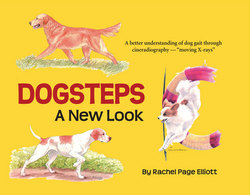Читать книгу Dogsteps - Rachel Page Elliott - Страница 4
На сайте Литреса книга снята с продажи.
ОглавлениеForeword
There has long been need for understandable information on various points of great concern to dog breeders.
Too often, people supervise the breeding of dogs without knowledge of what they are doing to the breed from a hereditary standpoint. Of the many faults that can be produced, probably the most obvious are those which contribute to lameness or poor gait.
Mrs. Elliott has recognized this need for the education of dog breeders in the basics of sound gait and performance. Based upon her years of association with show and field trial dogs, study of reel after reel of movie film, and the application of her findings to her own dogs, she has prepared this fine book.
It is especially aimed for the layman, with clear, simple wording and easy-to-understand drawings. Study of this material will aid in recognizing what is good and what is faulty action, and the application of what is learned should produce rewarding results for the conscientious dog breeder.
I compliment Mrs. Elliott for her deep insight into problems, her tireless work, and her devotion to the improvement of dog breeds by careful selection of parents. I hope this high quality book will be the first of a series clearly showing what can be achieved by proper breeding of dogs.
—E.W. Tucker, D.V.M. (Past president of the American Veterinary Medical Association, and of the Massachusetts Veterinary Association.)
One of the most valuable and pleasurable experiences of my life has been my long association and cherished friendship with Rachel Page Elliott. I was fortunate enough to have had the opportunity to travel with Pagey, primarily during the 1970’s and ’80’s, accompanying her to numerous seminars throughout the country. My job was to give a presentation on canine anatomy as a preliminary basis for her inspirational film and lecture on canine movement, and how a dog’s gait is correlated with his structure and soundness. I had the good fortune to spend many hours of discussion and deliberation with her on this subject during these trips, as well as the opportunity to come to know the remarkable person that she is. Pagey has always been an inquisitive, persistent and tireless worker in her pursuit of information. She has also been truly dedicated to her desire to help the dog enthusiast, whether he be novice or long time exhibitor, breeder or judge, to better understand the fundamentals of sound movement. I personally learned a great deal through my association with Pagey, and I consider her my highly respected and valued mentor, not only for her expertise in this field, but also as a most knowledgeable and devoted authority on her beloved Golden Retrievers.
Based upon her lectures came the publication of the first edition of her book Dogsteps in 1973. This reference work was a much needed and well-received addition to authoritative canine literature. Since then, she pursued her research with diligent and painstaking work utilizing cineradiography with Dr. Farish Jenkins at Harvard University’s Museum of Comparative Zoology. In 1983, she shared these radiographic findings on canine bone and joint motion with the dog fraternity in the second edition, entitled The New Dogsteps. These new findings were received with controversy from some individuals, but as a veterinarian with great interest in canine anatomy and movement, I am thoroughly convinced that there should be no contention over facts she so clearly presented.
It is with great anticipation that we have been looking forward to this latest revision of Mrs. Elliott’s authoritative book, if indeed there can be further additions or improvements over the previous version. This valuable work needs to be studied thoughtfully and thoroughly, if we are to fully understand and appreciate good canine movement.
—Elizabeth Trainor, D.V.M.
A strong, even gait is desirable in all breeds…
no matter the size… the shape… or purpose.
